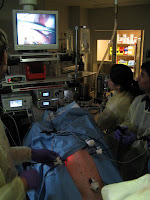Surgery for engineers II

On the last classes we were introduced to MIS laparoscopy. First we learned about the tools and the procedures, but more interestingly we moved to the OR afterwards to perform a laparoscopic cholecystectomy on a pig. The animal was already in anesthesia, we only had to make the incisions and insert the trocars. One could definitely see the MIS advantages compared to the previous week’s open procedure. We had some difficulties navigating around the smaller abdomen, but managed to end up in an uneventful surgery.
The other day we got introduced to many cutting edge research results of the new NOTES technique that aims to perform surgery without any scars, just getting into the cavity though the natural orifices. Our class got an hour and a half time with one of the two da Vincis at Hopkins, we could play on the test boards and setups provided by Intuitive Surgical. This was the first time that I used a robot with the original controller behind, it was really easy to handle, and the motions were very smooth. We also tried many other haptic simulators, suturing phantoms and training pads.
Finally, we were given an hour-long tour of the operating rooms. First, we visited the 24 ORs in the very old Blalock building, where they perform scheduled and emergency cases 24/7. Most interestingly, the major limitation is space here. All the rooms, the corners, the corridors are packed with the equipment instantly not in use. Dozens of C-arms, microscopes, anesthesia towers, Jackson tables (for spine operations) are piled up, leaving just enough place to navigate around with a patient on a bad. They have an extensive electronic system to manage all this. The newer building (Weinberg) was designed a lot wiser, leaving enough space for everything. The ORs are approximately 30-40m2, as much space is required for the technical equipments and their operators. Not rare to have 7-9 people in the OR at a case. A patient is billed 10USD/min for using the OR, and this does not include any of the equipment or the doctors’ fee. There are 14 more ORs in the hospital, but a major extension is on the way. By 2011, three new buildings will be added to the immense campus of Hopkins, providing 33 new ORs.
The other day we got introduced to many cutting edge research results of the new NOTES technique that aims to perform surgery without any scars, just getting into the cavity though the natural orifices. Our class got an hour and a half time with one of the two da Vincis at Hopkins, we could play on the test boards and setups provided by Intuitive Surgical. This was the first time that I used a robot with the original controller behind, it was really easy to handle, and the motions were very smooth. We also tried many other haptic simulators, suturing phantoms and training pads.
Finally, we were given an hour-long tour of the operating rooms. First, we visited the 24 ORs in the very old Blalock building, where they perform scheduled and emergency cases 24/7. Most interestingly, the major limitation is space here. All the rooms, the corners, the corridors are packed with the equipment instantly not in use. Dozens of C-arms, microscopes, anesthesia towers, Jackson tables (for spine operations) are piled up, leaving just enough place to navigate around with a patient on a bad. They have an extensive electronic system to manage all this. The newer building (Weinberg) was designed a lot wiser, leaving enough space for everything. The ORs are approximately 30-40m2, as much space is required for the technical equipments and their operators. Not rare to have 7-9 people in the OR at a case. A patient is billed 10USD/min for using the OR, and this does not include any of the equipment or the doctors’ fee. There are 14 more ORs in the hospital, but a major extension is on the way. By 2011, three new buildings will be added to the immense campus of Hopkins, providing 33 new ORs.


Comments